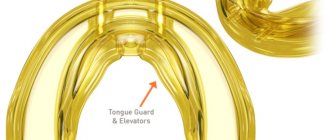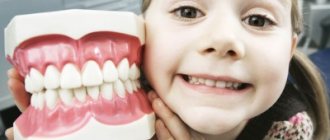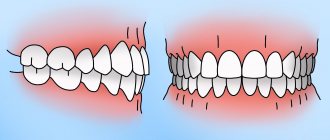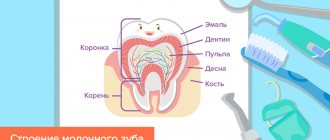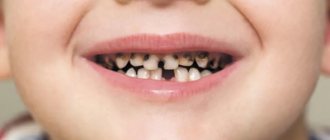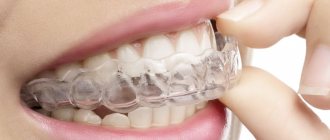1477
Teeth that are unevenly positioned relative to each other not only do not look aesthetically pleasing, but can also lead to many problems - increased stone formation, the development of caries and periodontal diseases.
Therefore, dentists recommend not delaying the process of correcting your bite. Modern orthodontics can offer patients a variety of designs that not only effectively correct defects, but are also practically invisible on the teeth.
Braces
The braces system is the most common design used to correct malocclusion in both children and adults. With its help, you can correct the position of individual teeth, reduce the distance between them, and change the incorrect contact of the jaws.
Vestibular
Vestibular type bracket systems are available in the range of all manufacturers of orthodontic structures. These products are fixed on the outer surface of the dentition.
Depending on the form of manufacture, ligature and self-ligating braces are distinguished:
- Ligature bracket system consists of several elements. Braces that are attached to the teeth.
The basis of the design is a power arc, which creates the necessary pressure to bring the teeth into the required position. Ligature fastenings with which the arch is attached to the staples.Ligatures can be made in the form of rubber rings or thin metal wires, which need to be changed over time. The key advantage of the products is the ability to correct complex malocclusion pathologies.
- Self-ligating systems are characterized by the absence of ligatures.
The arch is secured using special locks or clips. The product creates less discomfort during the correction period by reducing the friction force compared to ligature analogues. Caring for a self-ligating structure is much easier.
Vestibular devices are made from different materials, which affects their appearance and price:
- Metal products are made from special medical steel , so they do not cause allergies.
The power arc has a shape memory and tends to return to its original position, creating pressure on the teeth and directing them to the desired position. This design is very reliable, does not deform during use, and is recommended by dentists for complex pathologies that will require several years to correct. The cost of products per jaw is 2,500-3,000 rubles; when they are coated with precious metals, this amount increases to 25,000 rubles. - Ceramic structures look more aesthetically pleasing than metal ones .
The plates of the product are identical to enamel and are not painted during use. They are securely fixed to the teeth without coming off under the influence of chewing load. At the same time, ceramic braces are more fragile, so they should not be used in case of serious pathologies of the structure of the dentition. The cost of the ceramic system is 45-55 thousand rubles. - To make sapphire braces, artificially grown sapphire crystals are used. They are absolutely transparent and invisible on the tooth surface, therefore they are often used when it is necessary to correct the bite in adult patients.
Thanks to special processing, the products do not oxidize, do not stain, and do not injure the mucous membrane of the gums. Despite their strength, sapphire structures can crack under strong impact, so they are also not recommended for correcting complex dental anomalies. Their average cost reaches 55 thousand rubles.
Lingual
A special feature of lingual braces is that they are fixed on the inside of the teeth, making the clasps invisible to strangers when communicating.
The production of such a structure is a rather labor-intensive process, and requires the creation of a 3D model of the jaw to accurately account for all the features of its structure.
In addition to inconspicuousness, the advantage of the lingual brace system is the ability to eliminate complex bite pathologies by creating strong pressure.
At the same time, it is much more convenient for the dentist to evaluate the intermediate result of the correction process when the braces are on the lingual side of the teeth.
Among the disadvantages of this design, one can note its cost - for the manufacture of a product for one jaw you will have to pay 80-90 thousand rubles.
The most common brands of braces are:
- Incognito is a system from a German manufacturer. Its peculiarity is that the locks are made of gold, which avoids the occurrence of an allergic reaction. These braces have the highest cost among lingual models.
- STB braces are made from medical metal. The design is self-ligating, creating minimal friction between the power arc and the latch, reducing treatment time.
- Inovation – L is another ligature-free system. It is distinguished by the small size of the locks, which helps create minimal discomfort during use.
- Forestadent 2 d are small flat braces with a carefully polished surface, which are used for minor malocclusion pathologies. The process of getting used to it happens very quickly, and there is no discomfort when wearing it.
Mouth guards
Aligners or aligners are removable orthodontic devices made of a transparent polymer material that does not cause allergies.
They are placed over the teeth and worn for 20 hours a day. To correct a bite in this way, at least 10 pairs of aligners are required. In case of complex pathology, their number can reach 40-50 pairs, which change every 2 weeks.
With the help of mouth guards, you can correct problems such as crowded teeth, enlarged gaps between them, and crossbite.
The advantages of this method are the relative invisibility of the aligners on the teeth, the absence of pain, discomfort and impairment of diction while wearing them.
Among the disadvantages of using mouthguards, experts note their ineffectiveness for crooked teeth and serious malocclusions. In addition, the correction period using such products increases significantly compared to braces.
The cost of eliminating defects using mouthguards often starts from 100,000 and reaches 200,000 rubles.
Find out whether it hurts to put braces on your teeth and how the procedure goes.
In this publication we will tell you what T4a trainers are.
Follow the link https://orto-info.ru/sistemyi-vyiravnivaniya-zubov/breketyi/bezligaturnye-samoligiruyushhie.html to see photos of non-ligature braces.
Trainers
Elastic positioners or trainers are a structure made of elastic polymer material that is placed on two jaws.
The product affects both the elements of the jaw row and the muscles, which helps speed up the process of correcting pathological occlusion.
Trainers can be used not only by adults. Dentists recommend starting to use the device during the primary and mixed dentition, when the correction process occurs faster.
With the help of elastopositioners, it is possible to correct such anomalies of the jaw structure as misaligned teeth, loose jaw joints, and increased tone of the chin muscles.
If the dentist diagnoses a mesial or open bite, as well as a strong deviation of some teeth from the midline of the jaw, it is worth looking for another method of correcting the problem.
Among the disadvantages of trainers, patients note a long time of adaptation, discomfort during use, and a gradual change in the color of the structure under the influence of food coloring.
The device must be worn for 2-3 hours a day. The course of treatment is often about 1.5-2 years. The cost of an orthodontic product ranges from 6 to 10 thousand rubles.
Comments
I wanted to get an implant, but the doctors say that I first need to straighten my teeth. But why should I do this, I don’t understand? They want to collect money from me! I looked at how expensive these braces are!!! But my goal is different - implantation, so that I can finally chew normally with a tooth that has not been restored for 5 years.
SN (05.29.2021 at 23:23) Reply to comment
- Unfortunately, if the patient does not restore the tooth within the next year after its removal, pathological changes occur in the maxillofacial apparatus. The teeth located adjacent to the lost one begin to shift into its place. If they have time to move enough, then there is little space left, and it simply won’t be possible to place an implant and crown there right away. To do this, you need to move the teeth back, and therefore such patients require orthodontic correction before implantation. Most likely, this happened in your case, so it is unlikely that the doctors’ goal is solely to collect money from you. If in doubt, consult with different clinics to hear everyone's opinions on your clinical situation.
Reply from the author of the article (06/01/2021 at 09:12) Reply to comment
Write your comment Cancel reply
Records
An orthodontic plate is designed to correct the position of one or more teeth in the jaw.
It consists of a palatal plane and a power arc that exerts pressure on certain elements of the dentition.
Dentists recommend using the plate for the following pathologies:
- large gaps between teeth;
- increased crowding of the elements of the jaw line;
- protrusion of some teeth in relation to others.
The advantages of bite correction using plates include their low cost and the absence of discomfort during use.
At the same time, dentists note that such structures are unable to cope with complex anomalies in the location of teeth.
The disadvantages of the plates include the need to use them throughout the day, removing them from the oral cavity only when eating and performing hygiene procedures..
Is it possible to straighten teeth at home?
Surely many people are interested in whether it is possible to straighten teeth at home. Don’t think that this can be done with the wave of a magic wand or using folk remedies. Teeth straightening at home means the use of aligners, trainers or elastopositioners. You will not be able to choose these designs yourself. You will need to contact an orthodontist - a doctor who straightens teeth, who will conduct an examination and tell you exactly whether removable structures will help in your case. Without a specialist, you won’t be able to cope with your problem - you shouldn’t even try. Attempting to straighten teeth without an orthodontist can lead to irreversible consequences.
Lip bumpers
The lip bumper is a metal arch that is attached to the last molars and extends into the outer side of the dentition without touching the teeth.
This device is designed to speed up the process of straightening the lower teeth, reducing pressure on them from the lips and cheeks, lengthening the dental arch and preventing the formation of crowding.
Lip bumpers are most often used in childhood to correct the position of the teeth in the lower jaw and consolidate the results obtained after using braces.
Depending on the modification, the cost of dental bumpers can range from 300 rubles to 6,000 rubles.
How do teeth become straight?
After the patient has been fitted with braces or has started treatment with aligners, the process of teeth straightening begins. The constant slight impact of the orthodontic system leads to the fact that the bone around the tooth changes: on the one hand it increases, and on the other it decreases. And the tooth moves to the desired point. It is important that the load is not excessive or insufficient - in either case, the treatment will not lead to the desired result. But an experienced orthodontist will not allow this to happen. It is to regulate the process of teeth straightening that you need to regularly visit your doctor. Treatment will last 1.5 – 2 years. After this, you will have to wear retainers for some time to fix the result.
Veneers
Veneers are thin plates of ceramic composition, which are fixed to the front side of the dentition, having previously ground it down.
This technology allows you to hide minor tooth defects - chips, cracks, unequal length, pigmentation, slight deviation from the midline of the jaw. This treatment option is not recommended for patients with pathological abrasion of enamel and untreated caries.
The disadvantages of the method include the high cost of the plates and the need to replace them every 10 years.
One ceramic veneer costs about 7 thousand rubles, the price for a product made of zirconium dioxide increases to 11 thousand.
What is the Derichsweiler apparatus and for what anomalies is its use required?
Read reviews about STB lingual braces here.
At this address https://orto-info.ru/sistemyi-vyiravnivaniya-zubov/lechebno-profilakticheskie-apparatyi/ortodonticheskie-treyneryi.html you will find detailed information about orthodontic trainers for teeth.
How to straighten your front teeth?
In some cases, the dentition has slight deficiencies, for example with the front teeth. The orthodontist will tell you how to straighten your front teeth. He may recommend getting braces or treatment with aligners. However, sometimes cosmetic dentistry can help straighten the two front teeth. If there are no bite defects, you should consult an orthopedist - a doctor who specializes in prosthetics. He can offer the option of installing a veneer - an overlay 0.5 - 0.7 mm wide, which allows you to make your smile perfect. This technology has its pros and cons. An undoubted advantage is the speed with which the installation is carried out - just a few days, and the problem is solved. Here's a way to quickly straighten your teeth. Another plus is the service life. One of the disadvantages is the need to grind the tooth, and this is an irreversible process. In the same way, you can straighten 1 tooth, and not necessarily the front one. Sometimes an orthodontist suggests straightening the lower teeth without using braces or aligners and using veneers or lumineers. In each specific case, consultation with a doctor is necessary.
Surgical intervention
Correcting the bite using surgical intervention allows you to get the maximum result, which cannot be achieved using any orthodontic structures.
This process is carried out by cutting or dissecting bone tissue in order to lengthen or shorten the jaw and adjust the shape of the chin.
Indications for surgical correction are the following pathologies:
- open frontal bite;
- distal bite;
- open lateral bite;
- pathological structure of the chin.
The cost of surgery to correct the bite depends on the complexity of the pathology that needs to be corrected and the implementation of a set of additional manipulations.
On average, the cost of osteotomy is 11-12 thousand rubles.
Watch the video about surgical correction of the bite.
Where can I straighten my teeth and how long will it take?
It is better to choose a dental clinic for bite correction carefully. Ask your friends and acquaintances if they can recommend where to straighten your teeth. Get acquainted with clinic websites and reviews of doctors’ work. A little research will save you from possible disappointment. An extremely low price should alert you: in such cases, the clinic probably simply does not indicate the cost of additional procedures.
The duration of treatment and price depend on the diagnosis made by the orthodontist. Usually, the doctor can immediately determine exactly in what period it will be possible to straighten the teeth and how much time it will take. Usually, on average, it takes 1.5 – 2 years to straighten teeth with braces. It is impossible to say which braces straighten teeth faster. All braces are effective. Except that with plastic braces, treatment may take longer - they break, and the doctor has to replace parts of the structure, and this delays the treatment time. If you only need to fix one or two teeth and you decide to get veneers, the entire treatment is unlikely to take more than 2 weeks.
There are many ways to straighten your teeth. You just have to decide to change your smile, and after a while you will definitely achieve it. The question of whether teeth need to be straightened should not even arise. Of course you need it! With a beautiful smile, most likely, your attitude towards yourself and the world will change for the better!
In the modern world, teeth straightening is a standard procedure that millions of people of different ages undergo. The fact is that a beautiful smile is not only the key to personal success, but also a means of maintaining health. Some dental abnormalities can cause diseases of various body systems. If you are looking after your health, you should not ignore the presence of dental anomalies. Straightening your teeth and making your smile perfect is not so difficult, and the result will delight you for the rest of your life!
Composite restoration
Restoration of teeth using composite material allows you to restore the shape of the elements of a row in case of various chips and destructions.
After preparing an incisor or molar, a special reflective composition identical to enamel is applied to it. After grinding and polishing, the restored tooth is practically no different from the rest.
The advantages of the method include its accessibility, aesthetics and quick effect. Among the disadvantages are the possibility of darkening of the composite material and a short service life.
The cost of tooth restoration using this method starts from 600 rubles and reaches 4000 rubles, depending on the manufacturer of the composite composition.
Method number 2: therapeutic
Many people wonder whether it is possible to straighten teeth without orthodontic appliances. This is only possible if the bite pathology is minor, affects only one or several elements of the row, and the normal functionality of the maxillofacial apparatus is not impaired.
So, if a patient has 1-2 elements in his mouth that are slightly curved or imperfect in shape (type), they can be corrected using artistic extensions. This procedure is also suitable for those who have diastemas (cracks), stains, chips, cracks - you can comprehensively hide all defects.
Using artistic extensions you can correct 1-2 teeth
This method allows you to straighten your teeth quickly, in just 1 visit to the clinic. And at the same time inexpensive. How? The dentist-therapist, namely he who carries out this procedure, will first clean the elements from plaque. Then he will sharpen the hard tissues a little (otherwise the restoration will look unnatural, convex, and it will not be possible to correct the curvature). Next, the specialist will apply the composite material layer by layer to the problem element, like a sculptor, giving it the desired shape and appearance, achieving a natural shade so that it does not differ in color from the patient’s natural enamel.
“They somehow persuaded me to have my teeth straightened at the dentist. It really stood out against the general background, although it didn’t bother me personally. In the end they sharpened it for me and covered it with a filling, it seemed to look good. But I wasn’t happy for long. After 2 years, all this beauty turned very yellow and began to fly off in pieces. And now it has become clearly visible that this is an artificial material, not enamel. I already regretted that I agreed then, I should have left everything of my own, since nothing was embarrassing.”
AliNochka, review from woman.ru
Myogymnastics
Myogymnastics is a set of specific exercises for the muscles of the oral cavity, which allows you to correct various occlusion pathologies.
This is a type of physical therapy that can be used independently or in combination with hardware therapy.
The effectiveness of myogymnastics depends on how complex the bite pathologies are, as well as at what age the therapy is intended.
Orthodontists recommend starting this therapy during primary occlusion – between the ages of 4 and 8 years.
Regular exercise helps reduce muscle dysfunction, enhance bone growth, and restore impaired jaw functions.
Cost of treatment
The cost of straightening teeth without braces depends on the method chosen. But in any case, aligners and trainers, not to mention veneers and composite restorations, cost much less than any bracket system. Moreover, the difference becomes very significant if we compare lingual or sapphire structures with orthodontic aligners.
In many dental clinics, during the initial consultation and examination, the doctor creates a virtual 3D setup, which allows you to immediately calculate the required number of trays, and with it the final cost of treatment.
In addition, patients should consider the cost of preparatory measures, which include professional cleaning and sanitation of the oral cavity, as well as diagnostic procedures such as x-rays.
Bite correction in adults
Correcting a bite when the dentition has formed requires some effort and time.
In addition to improper positioning of teeth, patients are often diagnosed with additional problems - inflammation of periodontal tissue, tartar, caries, and enamel fragility.
Therefore, the choice of orthodontic design must be made taking these factors into account.
Orthodontists believe that braces are more preferable in adults than other designs, since they have the maximum impact on the teeth whose position needs to be corrected. In addition, this method of bite correction often takes the least time.
If there are minor pathologies in the structure of the dentition, you can limit yourself to alternative methods - aligners, aligners, veneers.
Correction of defects in children
During primary occlusion, dentists advise a careful approach to the issue of occlusion correction, since the process of development of the jaw apparatus continues.
At this time, it is advisable to avoid the use of orthodontic structures, which can harm the child’s dental system.
Recommendations of orthodontists for bite correction include the following measures:
- elimination of bad habits that contribute to the pathological development of the child’s jaws - finger sucking, pacifiers, placing the tongue between the teeth;
- formation of natural nasal breathing;
- performing gum tissue massage during teething;
- regular performance of myogymnastic exercises.
Dentists consider the optimal time to correct a bite using orthodontic structures to be between 10 and 18 years of age.
At the same time, it is important to choose a device for correcting the bite in such a way that it causes the child a minimum of discomfort in everyday life.
For more information on straightening children's teeth, watch the video.



